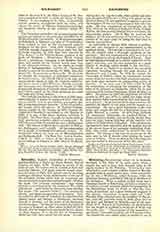

Kilwinning, BENEDICTINE ABBEY of, in Ayrshire, Scotland, in the town of the same name, where a church was said to have been founded early in the eighth century by St. Winning. Winning has been identified by some scholars with St. Finnan of Moville, an Irish saint of much earlier date; other authorities say he was a Welshman, called Vynnyn, while the Aberdeen Breviary (published 1507) gives Scotland as his birthplace. What is certain is that there was a Christian church at Kilwinning, and also a monastery of Culdees, several centuries before the foundation of the Benedictine house by Hugh de Morville, Constable of Scotland, and a great territorial magnate of the district, somewhere between 1140 and 1162.Timothy Pont, who had seen the cartulary of the abbey, now lost, and who wrote in 1608, gives 1171 as the date, and Richard de Morville (one of the murderers of St. Thomas of Canterbury) as the founder; but the weight of evidence is in favor of Hugh and the earlier date. “The structure of this monastery”, says Pont “was solid and grate, all of freestone cutte, the church fair and staitly after ye model of yat of Glasgow, with a fair steiple of 7 score foote of height, yet standing quhen I myselve did see it”. The length of the church was 225 feet, breadth of the nave sixty-five feet; and the monastic buildings covered several acres.
A community of Tyronensian Benedictines was brought from Kelso; the abbey was soon richly endowed by royal and noble benefactors, possessing granges, large estates, and the tithes of twenty parish churches, and a revenue equivalent to some £20,000 a year. For nearly four centuries Kilwinning remained one of the most opulent and flourishing Scottish monasteries. The last abbot was Gavin Hamilton, who whilst favoring the Reformation doctrines was a strong partisan of Queen Mary. He was killed in a fight outside Edinburgh in June, 1571. The suppression and destruction of the abbey soon followed, and its possessions, held for a time by the families of Glencairn and Raith, were erected in 1603 into a temporal lordship in favor of Hugh, Earl of Eglinton, whose successors still own them. The Earls of Eglinton have taken some pains to preserve the remains of the buildings, which include the great west doorway with window above, the lower part of the south wall of nave, and the tall gable of south transept with its three lancet windows. The “fair steiple” was struck by lightning in 1809, and fell down five years later.
D. O. HUNTER-BLAIR

